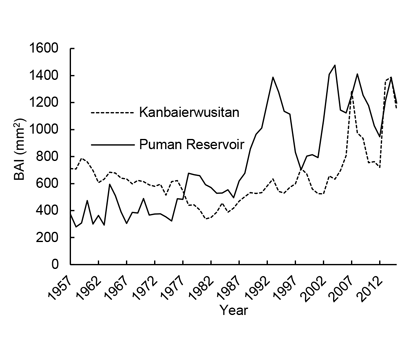

Response of Radial Growth of Populus euphratica to Runoff in the Tarim River
Received date: 2017-11-09
Online published: 2018-08-06
Taking the Populus euphratica forest in the main stream of the Tarim River as the research object, the two sections of the Puman reservoir and Kanbaierwusitan were selected to analyze the characteristics of the radial growth of P. euphratica in the middle reaches of the upper reaches of the Tarim River. The runoff data from cross sections were selected and the response of the radial growth of P. euphratica to the dynamic change of runoff was studied by wavelet analysis and correlation analysis. In the Puman reservoir-Xinqiman section, the basal area increment (BAI) for P. euphratica and the runoff scale all oscillated in a 15-24 year time, and the year of the runoff concussion was earlier than the BAI oscillation year. In the Kanbaierwusitan-Yingbazha section, the BAI for P. euphratica and the runoff scale all oscillated in a 10-20 year time, and the year of the runoff concussion was earlier than the BAI oscillation year. In the main stream of the Tarim River, runoff was one of the main factors limiting the radial growth of P. euphratica. The BAI for P. euphratica was significantly correlated with runoff from November of the previous year to March of this year. In the midstream of the Tarim River, The BAI for P. euphratica was significantly correlated with the runoff from December of the previous year to March of this year. The sensitivity of P. euphratica BAI to runoff variation in different sections of Tarim River differed. In the upstream sampling area of the Tarim River, a reasonable runoff reached 1.334 0×108 m3, and P. euphratica grew well. The range of optimal radial flow of P. euphratica growth in the sampling area was 0.380 3×108 -1.205 6×108 m3 in the middle reaches of the Tarim River.

Gou Xiaoxia , Ye Mao , Wang Liangliang , Gou Xiaohong . Response of Radial Growth of Populus euphratica to Runoff in the Tarim River[J]. Chinese Bulletin of Botany, 2018 , 53(6) : 801 -811 . DOI: 10.11983/CBB17212
| [1] | 曹春福, 周非飞, 董志鹏, 李颖俊, 张雨, 李大稳, 甘展峰, 方克艳 (2016). 福建戴云山台湾松树轮——气候响应的线性和非线性模式研究. 亚热带资源与环境学报 11, 44-51. |
| [2] | 陈亚宁, 李卫红, 陈亚鹏, 徐长春, 张丽华 (2007). 新疆塔里木河下游断流河道输水与生态恢复. 生态学报 27, 538-545. |
| [3] | 邓潮洲, 张希明, 李利, 吴俊侠, 刘国军, 闫海龙, 朱军涛, 吕朝燕 (2010). 河道输水对塔里木河下游胡杨生长状况的影响. 中国沙漠 30, 312-318. |
| [4] | 勾晓华, 邓洋, 陈发虎, 杨梅学, 方克艳, 高琳琳, 杨涛, 张芬 (2010). 黄河上游过去1234年流量的树轮重建与变化特征分析. 科学通报 55, 176-183. |
| [5] | 苟晓霞, 叶茂, 高生峰, 徐俏 (2017). 塔里木河中游胡杨径向生长对气候变化的响应研究. 西北植物学报 37, 1864-1871. |
| [6] | 韩路, 王海珍, 彭杰, 莫治新 (2007). 塔里木河上游天然胡杨林种群空间分布格局与动态研究. 西北植物学报 27, 1668-1673. |
| [7] | 李江风 (1989). 塔克拉玛干沙漠气候和利用. 干旱区研究 (1), 1-8. |
| [8] | 李江风, 袁玉江, 由希尧 (2000). 树木年轮水文学研究与应用. 北京: 科学出版社. |
| [9] | 李霞, 侯平, 杨鹏年 (2006). 塔里木河下游胡杨对水分条件变化的响应. 干旱区研究 23, 26-31. |
| [10] | 李宗善, 刘国华, 傅伯杰, 张齐兵, 胡婵娟, 罗淑政 (2011). 不同去趋势方法对树轮年表气候信号的影响——以卧龙地区为例. 植物生态学报 35, 707-721. |
| [11] | 刘普幸 (2007). 额济纳旗胡杨径向生长的水文气候因子研究. 博士论文. 兰州: 兰州大学. |
| [12] | 刘普幸, 陈发虎, 靳立亚, 勾晓华, 张永香, 彭剑峰 (2007). 基于胡杨年轮重建黑河下游近100年春季径流量. 干旱区地理 30, 696-700. |
| [13] | 刘禹, 吴祥定, 安芷生, 祝一志, 邵雪梅, 刘洪滨, 李兆元 (1997). 树轮密度、稳定C同位素对过去近100a陕西黄陵季节气温与降水的恢复. 中国科学(D辑: 地球科学) 27, 271-276. |
| [14] | 马利民, 刘禹, 赵建夫 (2003). 交叉定年技术及其在高分辨率年代学中的应用. 地学前缘 10, 351-355. |
| [15] | 邵雪梅, 吴祥定 (1997). 利用树轮资料重建长白山区过去气候变化. 第四纪研究 17, 76-85. |
| [16] | 涂文霞 (2014). 塔里木河不同河段胡杨径向生长与地表径流的关系研究. 硕士论文. 乌鲁木齐: 新疆师范大学. |
| [17] | 涂文霞, 叶茂, 徐海量, 白元 (2014). 塔里木河不同河段胡杨径向生长及径流的影响差异. 干旱区研究 31, 508-515. |
| [18] | 王金山, 哈力克·玉米提, Cyffka B, 吾斯曼·库尔班, 彭树宏 (2008). 塔里木河下游胡杨林胸径结构及林木分布特征. 植物学通报 25, 728-733. |
| [19] | 汪亮亮, 叶茂, 张同刚, 高生峰, 徐俏, 苟晓霞 (2017). 阿克苏河径流量变化对胡杨年轮生长的影响. 中南林业科技大学学报 37(7), 112-117. |
| [20] | 王希义, 徐海量, 凌红波, 白元 (2013). 塔里木河中游荒漠河岸林物种多样性对地下水埋深变化的响应. 西北植物学报 33, 2071-2076. |
| [21] | 徐海量, 宋郁东, 陈亚宁 (2003). 生态输水后塔里木河下游地下水的动态变化. 中国环境科学 23, 327-331. |
| [22] | 叶茂, 徐海量, 龚君君, 安红燕 (2011). 不同胸径胡杨径向生长的合理生态水位研究. 地理科学 31, 172-177. |
| [23] | 袁玉江, 周文盛, 张治家 (1989). 乌伦古湖水位下降与乌伦古河水量变化分析. 水文 (4), 138-144. |
| [24] | 张小炎, 袁玉江 (1989). 用年轮年表重建塔里木中游年径流量. 见: 李江风著. 新疆年轮气候年轮水文研究. 北京: 气象出版社. pp. 131-137. |
| [25] | 张永香, 勾晓华, 胡文东, 彭剑峰, 刘普幸 (2005). 树轮记录的贺兰山区近百年来的干旱事件. 生态学报 25, 2121-2126. |
| [26] | 张元明, 陈亚宁, 张道远 (2003). 塔里木河中游植物群落与环境因子的关系. 地理学报 58, 109-118. |
| [27] | 张芸, 叶茂 (2016). 塔里木河下游不同断面胡杨径向生长对地下水变化的敏感性研究. 西北植物学报 36, 818-824. |
| [28] | 张芸, 叶茂, 汪亮亮, 王敬哲 (2017). 塔里木河源流和干流胡杨年轮生长的差异性. 生态学报 37, 6081-6090. |
| [29] | 赵少军, 魏强, 徐海量, 郭宏伟, 王希义, 赵新风 (2017). 树木年轮对塔里木河生态环境变迁的印证. 中国沙漠 37, 594-600. |
| [30] | 周文盛 (1984). 根据阿尔泰山南坡树木年轮初步分析额尔齐斯河500年(1582-2081)径流量. 新疆地理 7, 35-50. |
| [31] | Biondi F, Qeadan F (2008). A theory-driven approach to tree-ring standardization: defining the biological trend from expected basal area increment.Tree-Ring Res 64, 81-96. |
| [32] | Cook ER, Briffa KR, Meko DM, Graybill DA, Funkhouser G (1995). The “segment length curse” in long tree-ring chronology development for palaeoclimatic studies.Holocene 5, 229-237. |
| [33] | IPCC (2013). Climate change 2013: the physical science basis. In: Working Group I Contribution to the Fifth Assessment Report of the Intergovernmental Panel on Climate Change. Cambridge: Cambridge University Press. |
| [34] | Liang EY, Ren P, Zhang SB, Shao XM, Eckstein D (2013). How can Populus euphratica cope with extremely dry growth conditions at 2800 m a.s.l. on the northern Tibetan Plateau. Trees 27, 447-453. |
| [35] | Meko D, Stockton CW, Boggess WR (1995). The tree-ring record of severe sustained drought.J Am Water Resour Assoc 31, 789-801. |
| [36] | Seifert T, Meincken M, Odhiambo BO (2017). The effect of surface fire on tree ring growth of Pinus radiata trees. Ann Forest Sci 74, 34. |
| [37] | Woodhouse CA (2001). A tree-ring reconstruction of stream- flow for the Colorado Front Range.J Am Water Resour Assoc 37, 561-570. |
/
| 〈 |
|
〉 |